
. . . . . . . . . . . . . . . . . . . . . . . . . . . . . .
1-12 Overview
Writer: Fran Spragens Project: Overview Comments: 355307-002
File Name:3324_1.doc Last Saved On:3/16/99 11:31 AM
RMON
RMON (Remote Monitoring) is a facility used to manage networks remotely while
providing multi-vendor interoperability between monitoring devices and
management stations. An SNMP MIB defines RMON. This MIB is divided into
nine different groups, each gathering specific statistical information or performing
a specific function. RMON-capable devices gather network traffic data and then
store them locally until downloaded to an SNMP management station.
The switch supports four of the nine groups of RMON defined for Ethernet
networks on a per port basis. Specifically, these are:
n Statistics: a function that maintains counts of network traffic statistics
such as number of packets, broadcasts, collisions, errors, and
distribution of packet sizes.
n History: a function that collects historical statistics based on user-
defined sampling intervals. The statistical information collected is the
same as the Statistics group, except on a time stamped basis.
n Alarm: a function that allows managers to set alarm thresholds based on
traffic statistics. Alarms trigger other actions through the Event group.
n Event: a function that operates with the Alarm group to define an action
that will be taken when an alarm condition occurs. The event may write
a log entry and/or send a trap message.
RMON Statistics group information is displayed on the Port Statistics Screen in
the console menus. Additional RMON functionality is available via SNMP.
Port Mirroring
The switch includes the ability to mirror the traffic being switched on any port
for purposes of network traffic analysis and connection integrity. When this
feature is enabled, a protocol analyzer or RMON probe is connected to any port
in a group of eight. This port is configured to mirror the traffic from any other
port in the same group of ports. The groupings are ports 1-8, 9-16 and 17-24.
You can only mirror one port to another port at one time. Port mirroring occurs
at the same speed configured for the port (10Mb/s-to-10Mb/s or 100Mb/s-to-
100Mb/s). Port mirroring is configurable in the Switch Configuration Menu
using the console menus or via SNMP.
NOTE: Port mirroring is not supported on the Gigabit Ethernet ports.


















